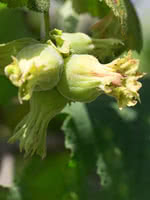Mon-Fri 9am - 5pm Mountain time
Black Locust vs Yamhill Hazelnut
Robinia pseudoacacia
Corylus avellana Yamhill
NOT AVAILABLE THIS SEASON - MIGHT RETURN
Black Locust is an attractive tree. Its distinctive leaves are made of about a dozen bright green leaflets. It also notable for its fragrant white flowers, which smell of citrus.
Black Locust can grow in many situations, but prefers dry areas with lots of sun. It is robust and is an excellent choice for establishing shade in dry, open areas.
Important note: Much of the Black Locust is toxic to humans and livestock, including seeds, bark, and leaves.
The Yamhill Hazelnut is a tasty, relatively cold hardy hazelnut that is a popular European variety.
It is known to be a strong grower and has moderate eastern filbert blight resistance. It is a suitable pollinizer for the York Hazelnut and European Hazelnut.
Introduced by Oregon State University, The Yamhill Hazelnut is used by Ferror Roche for their candy and chocolate spread desserts.
Not all hazelnuts pollinate with each other so it is important to pick the correct pollination pairs. Two compatible varieties of hazelnut are required to produce nuts. Nuts will only be produced once maturity is reached, around 2-3 years.

